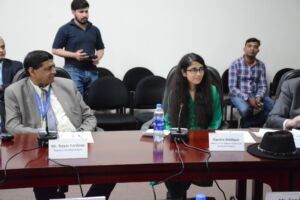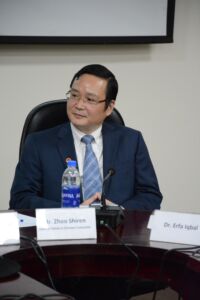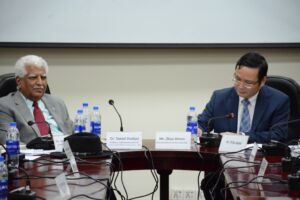
China-Pakistan Relations in the Twenty-First Century’ by Ayesha Siddique
Book Launch
Past Event
|
Centre for Public Policy and Governance
FCC Lahore
Upcoming Event
Ayesha Siddique, Research Associate at the Centre for Public Policy and Governance at Forman Christain College University, launched her book “China-Pakistan relations in the Twenty-First Century” on March 10, 2022. Dr. Katherine Adenny, Professor of Comparative Politics at the University of Nottingham and Ambassador Masood Khalid, a career diplomat and Pakistan’s longest-serving ambassador to China, were invited as distinguished commentators. Dr. Saeed Shafqat, moderated the event while Dr. Jonathan Addleton, was present to give a vote of thanks and to conclude the event.
The session started with Ayesha pointing out that her book caters to a wide range of audiences, from businessmen to policy makers and students. Contrary to mainstream literature, which heavily focuses on China and Pakistan’s geostrategic relationship, her book focuses on the two nations’ geoeconomic relationship. It prioritizes present-day dynamics over historical analysis and presents a perspective from the global South.
Ayesha proceeded to outline her book’s framework briefly. Divided into seven chapters, the first three delve into the two countries’ economic relationship. The rest explain the technological cooperation, education, and cultural exchanges the two share while the last chapter concludes with a discussion of potential challenges.
Starting with analyzing Pakistan and China’s economic dynamics, Ayesha explained that the first chapter in this regard addresses the scale of economic and financial cooperation between the two countries. The chapter also discusses various contractual agreements between the two countries regarding currency swaps, the volume of bilateral trade, etc. Given that China’s economy is at least thirty times bigger than Pakistan’s, it is essential to explore the sustainability of their bilateral relationship.
The second chapter critically reviews the CPEC projects. CPEC is one of the six corri2dors of China’s Belt and Road Initiative (BRI), a comprehensive economic, cultural, and political network intended to promote connectivity along the Silk Road. She emphasized that CPEC has opened avenues of cooperation in various areas, including industrial, economic, financial, and business sectors. Contrary to popular opinion, her research concludes that most CPEC projects are significantly complete and have contributed to improving the energy crisis, road connectivity and port connectivity. She argued that if strategized and implemented as envisioned by the CPEC project, it benefits both China and Pakistan; however, certain reforms are a prerequisite.
Ayesha pointed out that she dedicated a separate chapter to the Asian Infrastructure Investment Bank (AIIB); no previous study was done on China’s engagement with Pakistan through the AIIB. She explains and compares the AIIB with other multilateral development banks like The World Bank and Asian Development Bank in her book. Sharing her research findings, she pointed out that, similar to other multilateral development banks, AIIB also had shortcomings in voting structure, governance structure, and membership. The book also provides a detailed analysis of the projects financed by AIIB: nine of those projects are mostly related to the hydropower and water sector. She emphasized that the key takeaway is that both CPEC and AIIB are helping Pakistan to meet its infrastructure needs, redefining the China-Pakistan relationship, strengthening Asian regionalism, and the multilateral arrangements that underpin the Asian economic order.
Moving on, Ayesha outlined the nature of technological cooperation between China and Pakistan. She pointed out that China is a leading player in global technological value chains. In her book, she firstly compares the technological sophistication of China and Pakistan, using metrics such as R&D spending of China in Pakistan, number of supercomputers in China vs Pakistan, amongst others. Importantly there is the transfer of skills and knowledge, through partnerships, collaborations, and joint programs in several advanced ICT courses, artificial intelligence, and cloud computing projects.
Chapter 6 explores the two nation’s educational relations, analyzing the increase in the number of Pakistani students going to China for higher education. Ayesha explained that her research concludes that the number of students going to China has increased six times over the past ten years. A significant reason for this development is the growing competitiveness of the Chinese higher education system and the provision of Chinese government scholarships. A lot of th2ese scholarships are tied to CPEC projects. The scholarships also cater to the local needs, like the Gwadar-China scholarship intended for residents of Gawadar. The scholarship allows them to study the Chinese language at Chinese universities. Therefore, there is a deepening of education ties between China and Pakistan.
She also commented that the cultural relations between Pakistan and China are relatively weak and limited- she utilized three metrics: the scale of people-to-people exchanges, cross-border information flow, and Confucius Institutes, China’s primary cultural diplomacy tool. The first two metrics indicate limited cultural exchange. However, four Confucius Institutes have been established in Pakistan and have successfully disseminated Chinese language to eager Pakistani citizens.
In conclusion, Ayesha pointed out that Pakistan and China’s relations are expanding in the economic, technological, educational and cultural domains. She concluded that the twenty-first century augurs well for expansion, consolidation, charting, and mutually rewarding partnerships between China and Pakistan despite governance challenges.
Ambassador Khalid appreciated Ayesha’s contribution to the literature on Pakistan-China relations and highlighted the importance of consulting books written by relevant foreign policy practitioners. He argued that China and Pakistan had developed durable compatibility despite vast ideological and cultural differences because of mutual trust, respect, aligned interests, and non-interference in each other’s affairs. He elaborated on both countries’ shared history to strengthen the argument: the Sino-Indian war of 1962 was a defining moment. Pakistan was disappointed with the United States’ approach toward Kashmir and its relationship with India on security grounds and pivoted towards China. Ambassador Khalid pointed out that the landmark achievement of this relationship was the 1963 border treaty between Pakistan and China that laid the foundations of bilateral cooperation.
He emphasized that China’s role during the 1965 Pakistan-India war particularly cemented trust between the two countries. Despite the US suspending military assistance to Pakistan, China continued to help Pakistan. From 1965 onwards, both countries developed a cooperative and strategic partnership for bilateral and multilateral exchange. After the 1971 secession of Bangladesh, China provided large loans to the economically struggling Pakistan. When Prime Minister Bhutto raised the issue of delay in repayment of a hundred million dollar loan, China immediately converted the loan into a grant.
Ambassador Khalid elaborated on the mutual benefits of the relationship between China and Pakistan: both countries provide each other diplomatic and strategic space in a regional context. Pakistan has remained China’s most trusted partner in South Asia. China views Pakistan as a feasible, viable, cost-effective conduit to reach out to Central Asia, Afghanistan, and the Middle East through its BRI. He pointed out that China is also gaining from the relationship regarding access to the Indian Ocean. He noted that the Chinese leadership prioritizes their relationship with Pakistan in their regional foreign policy.
Ambassador Khalid highlighted reasons for greater academic and political interest in Pakistan and China’s relationship, these include recent developments in Afghanistan, Indo-US strategic partnership, CPEC and China’s quest for connectivity with the Euro-Asian region. He cautioned against deflecting problems arising from Pakistan’s governance incapacity, political instability, and economic vulnerabilities to China. They should instead inform our urgency for structural change.
Professor Adenny was then invited to deliver her remarks. She appreciated the boo2k’s focus on Imran Khan’s tenure since earlier literature almost exclusively focuses on developments during Nawaz Sharif’s government. She pointed out that contrary to mainstream discourse, the Pakistan Tehreek Insaaf (PTI) government has made some notable progress on the CPEC. Imran Khan particularly focused on repurposing CPEC to fit his job creation agenda.
Professor Adenny noted that the success of the Special Economic Zones (SEZs) formed in light of the CPEC project depends on effective project management, commitment, and long-term strategic planning by the Pakistani government. The Chinese investors seek more incentives to invest in the SEZs, as evidenced in the one established in KPK. Professor Adenny shared that provincial bureaucrats also emphasize the urgency of strategic direction to encourage corporations to develop in the SEZs. She expressed her disagreement with prioritizing the export of labor-intensive products to China. It only provides short term benefits; a better strategy is to focus on high-value exports to increase Pakistan’s GDP and reduce the trade deficits with China.
Professor Adenny argued that job creation should not be used as the sole metric of CPEC’s success: dignified and quality work should be prioritized over the number of jobs produced. Pakistan should focus on training opportunities and incentivizing high levels of education. If we bring in individuals from China to train the local population, they must be inclusive and accessible to Pakistan’s diverse student population. She cited the Gwadar-China scholarship program, saying that even though undeniably welcomed, it is minimal in numbers for the moment. Pakistan needs to strategize its investments and the conditions of Chinese investment: both need to be tied together.
She acknowledged the politicized nature of critiquing CPEC, whereby highlighting relevant issues is viewed as an American agenda. She noted that the Nawaz Sharif administration’s focus on energy projects garnered much attention; it would increase GDP and exports, and Pakistan would be able to pay off its debt to China. Professor Adenny sought to dispel this myth. She pointed out that, as noted in Matthew McCartney’s new book, export growth needs to grow about 10 to 15 percent each year for this to be a viable strategy. It seems unlikely given Pakistan’s recent history: recent World Bank figures show a drop in GDP per capita. This trend existed well before COVID-19. She also pointed out that some of the debt to China is bilateral; its share increased from 30 percent in 2015 to 36 percent in 2021.
Professor Adenny concluded by pointing out areas in which partnership with China can be best used to Pakistan’s advantage including high-value agricultural exports and managing water insecurity. She noted that focusing on higher-value products like citrus and mangoes may require China’s technical help and expertise. Water insecurity is one of Pakistan’s biggest challenges, and China can help with that. However, she cautioned, it might further solidify the trade imbalance between the two countries.
The session was then followed by a question and answer session and Dr. Addleton’s concluding remarks in which he thanked the experts for their time and appreciated Ayesha’s hard work and effort.
Event covered by Neha Malik.





